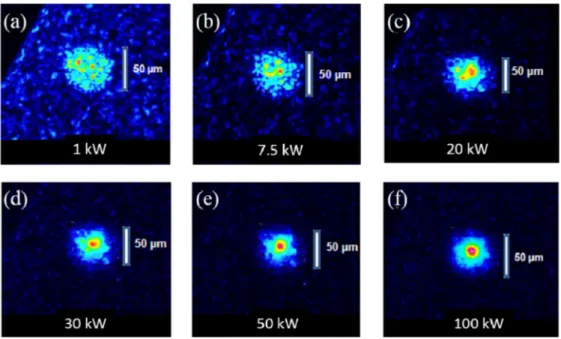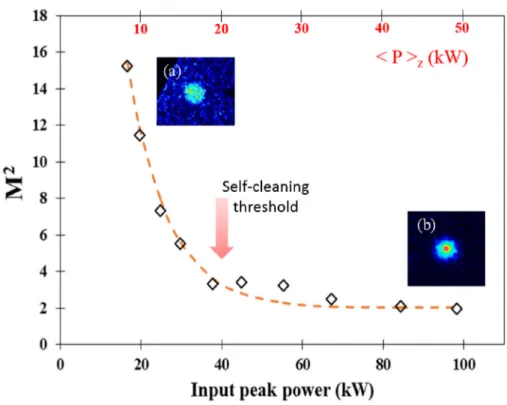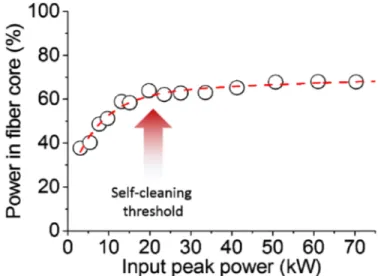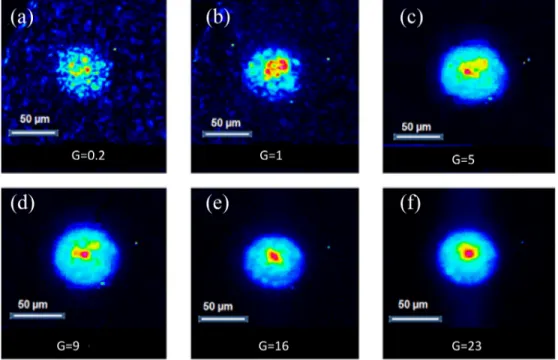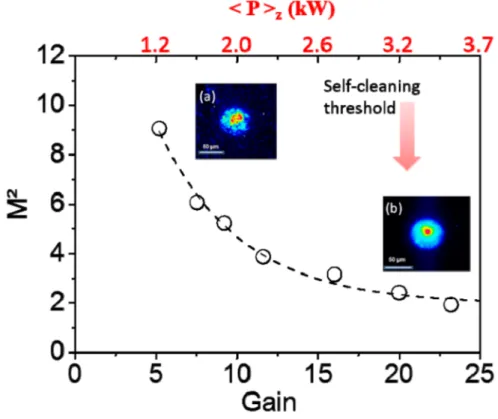Kerr self-cleaning of pulsed beam in an
ytterbium doped multimode fiber
R. G
UENARD,
1K. K
RUPA,
1,2R. D
UPIOL,
2M. F
ABERT,
1A. B
ENDAHMANE,
2V. K
ERMENE,
1A. D
ESFARGES-B
ERTHELEMOT,
1J. L. A
UGUSTE,
1A.
T
ONELLO,
1A. B
ARTHÉLÉMY,
1,*G. M
ILLOT,
2S. W
ABNITZ,
3,4ANDV.
C
OUDERC11Université de Limoges, XLIM, UMR CNRS 7252, 123 Avenue A. Thomas, 87060 Limoges, France 2Université de Bourgogne Franche-Comté, ICB, UMR CNRS 6303, 9 Av. A. Savary, 21078 Dijon,
France
3Dipartimento di Ingegneria dell’Informazione, Università di Brescia, and INO-CNR, via Branze 38,
25123 Brescia, Italy
4Novosibirsk State University, 1 Pirogova str., Novosibirsk 630090, Russia *[email protected]
Abstract: We experimentally demonstrate that Kerr spatial self-cleaning of a pulsed beam
can be obtained in an amplifying multimode optical fiber. An input peak power of 500 W only was sufficient to produce a quasi-single-mode emission from the double-clad ytterbium doped multimode fiber (YMMF) with non-parabolic refractive index profile. We compare the self-cleaning behavior observed in the same fiber with loss and with gain. Laser gain introduces new opportunities to achieve spatial self-cleaning of light in multimode fibers at a relatively low power threshold.
© 2017 Optical Society of America
OCIS codes: (060.4370) Nonlinear optics, fibers; (060.2370) Fiber optics sensors; (190.4420) Nonlinear optics,
transverse effects in; (190.3270) Kerr effect; (190.4223) Nonlinear wave mixing.
References and links
1. R. G. H. van Uden, R. Amezcua Correa, E. Antonio Lopez, F. M. Huijskens, C. Xia, G. Li, A. Schülzgen, H. de Waardt, A. M. J. Koonen, and C. M. Okonkwo, “Ultra-high-density spatial division multiplexing with a few-mode multicore fibre,” Nat. Photonics 8(11), 865–870 (2014).
2. I. N. Papadopoulos, S. Farahi, C. Moser, and D. Psaltis, “High-resolution, lensless endoscope based on digital scanning through a multimode optical fiber,” Biomed. Opt. Express 4(2), 260–270 (2013).
3. H. Defienne, M. Barbieri, I. A. Walmsley, B. J. Smith, and S. Gigan, “Two-photon quantum walk in a multimode fiber,” Sci. Adv. 2(1), e1501054 (2016).
4. G. P. Agrawal, Nonlinear Fiber Optics, 5th ed. (Elsevier Inc Ed., 2013).
5. S. Longhi, “Modulational instability and space-time dynamics in nonlinear parabolic-index optical fibers,” Opt. Lett. 28(23), 2363–2365 (2003).
6. P. Aschieri, J. Garnier, C. Michel, V. Doya, and A. Picozzi, “Condensation and thermalization of classsical optical waves in a waveguide,” Phys. Rev. A 83(3), 033838 (2011).
7. W. H. Renninger and F. W. Wise, “Optical solitons in graded-index multimode fibres,” Nat. Commun. 4, 1719 (2013).
8. H. Pourbeyram, G. P. Agrawal, and A. Mafi, “Stimulated Raman scattering cascade spanning the wavelength range of 523 to 1750nm using a graded-index multimode optical fiber,” Appl. Phys. Lett. 102(20), 201107 (2013).
9. L. G. Wright, W. H. Renninger, D. N. Christodoulides, and F. W. Wise, “Spatiotemporal dynamics of multimode optical solitons,” Opt. Express 23(3), 3492–3506 (2015).
10. L. G. Wright, S. Wabnitz, D. N. Christodoulides, and F. W. Wise, “Ultrabroadband dispersive radiation by spatiotemporal oscillation of multimode waves,” Phys. Rev. Lett. 115(22), 223902 (2015).
11. K. Krupa, A. Tonello, A. Barthélémy, V. Couderc, B. M. Shalaby, A. Bendahmane, G. Millot, and S. Wabnitz, “Observation of geometric parametric instability induced by the periodic spatial self-imaging of multimode waves,” Phys. Rev. Lett. 116(18), 183901 (2016).
12. K. Krupa, A. Tonello, B. M. Shalaby, M. Fabert, A. Barthélémy, G. Millot, S. Wabnitz, and V. Couderc, “Spatial beam self-cleaning in multimode fiber,” https://arXiv.org/abs/1603.02972 [physics.optics].
13. G. Lopez-Galmiche, Z. Sanjabi Eznaveh, M. A. Eftekhar, J. Antonio Lopez, L. G. Wright, F. Wise, D.
Christodoulides, and R. Amezcua Correa, “Visible supercontinuum generation in a graded index multimode fiber pumped at 1064 nm,” Opt. Lett. 41(11), 2553–2556 (2016).
#281486 https://doi.org/10.1364/OE.25.004783
14. K. Krupa, C. Louot, V. Couderc, M. Fabert, R. Guenard, B. M. Shalaby, A. Tonello, D. Pagnoux, P. Leproux, A. Bendahmane, R. Dupiol, G. Millot, and S. Wabnitz, “Spatiotemporal characterization of supercontinuum extending from the visible to the mid-infrared in a multimode graded-index optical fiber,” Opt. Lett. 41(24), 5785–5788 (2016).
15. L. G. Wright, Z. Liu, D. A. Nolan, M. J. Li, D. N. Christodoulides, and F. W. Wise, “Self-organized instability in graded index multimode fibre,” Nat. Photonics 10(12), 771–776 (2016).
16. Z. Liu, L. G. Wright, D. N. Christodoulides, and F. W. Wise, “Kerr self-cleaning of femtosecond-pulsed beams in graded-index multimode fiber,” Opt. Lett. 41(16), 3675–3678 (2016).
17. J. P. Koplow, D. A. V. Kliner, and L. Goldberg, “Single-mode operation of a coiled multimode fiber amplifier,” Opt. Lett. 25(7), 442–444 (2000).
18. T. Bhutta, J. I. Mackenzie, D. P. Shepherd, and R. J. Beach, “Spatial dopant profiles for transverse-mode selection in multimode waveguides,” J. Opt. Soc. Am. B 19(7), 1539–1543 (2002).
19. J. Limpert, H. Zellmer, A. Tünnermann, T. Pertsch, and F. Lederer, “Suppression of higher order modes in a multimode fiber amplifier using efficient gain-loss-management (GLM),” in Advanced Solid-State Lasers, (Optical Society of America, 2002), paper MB20.
20. X. Ma, C. Zhu, I.-N. Hu, A. Kaplan, and A. Galvanauskas, “Single-mode chirally-coupled-core fibers with larger than 50 µm diameter cores,” Opt. Express 22(8), 9206–9219 (2014).
21. R. Florentin, V. Kermene, J. Benoist, A. Desfarges-Berthelemot, D. Pagnoux, and A. Barthélémy, “Shaping the light amplified in a multimode fiber,” Light Sci. Appl. 6, e16208 (2017); (preview at
http://aap.nature-lsa.cn:8080/cms/root/light_1/index2.vm#August%2030%202016).
22. M.-A. Miri, P. LiKamWa, and D. N. Christodoulides, “Large area single-mode parity-time-symmetric laser amplifiers,” Opt. Lett. 37(5), 764–766 (2012).
23. M. Heinrich, M.-A. Miri, S. Stützer, R. El-Ganainy, S. Nolte, A. Szameit, and D. N. Christodoulides, “Supersymmetric mode converters,” Nat. Commun. 5, 3698 (2014).
24. L. Lombard, A. Brignon, J. P. Huignard, E. Lallier, and P. Georges, “Beam cleanup in a self-aligned gradient-index Brillouin cavity for high-power multimode fiber amplifiers,” Opt. Lett. 31(2), 158–160 (2006). 25. S. H. Baek and W. B. Roh, “Single-mode Raman fiber laser based on a multimode fiber,” Opt. Lett. 29(2), 153–
155 (2004).
26. Y. Glick, V. Fromzel, J. Zhang, A. Dahan, N. Ter-Gabrielyan, R. K. Pattnaik, and M. Dubinskii, “High power, high efficiency diode pumped Raman fiber laser,” Laser Phys. Lett. 13(6), 065101 (2016).
27. E. A. Zlobina, S. I. Kablukov, A. A. Wolf, A. V. Dostovalov, and S. A. Babin, “Nearly single-mode Raman lasing at 954 nm in a graded-index fiber directly pumped by a multimode laser diode,” Opt. Lett. 42(1), 9–12 (2017).
28. B. M. Flusche, T. G. Alley, T. H. Russell, and W. B. Roh, “Multi-port beam combination and cleanup in large multimode fiber using stimulated Raman Scattering,” Opt. Express 14(24), 11748–11755 (2006).
1. Introduction
Multicore and multimode optical fibers (MMFs) are currently extensively revisited [1] for their enhanced transmission capacity, mostly in the context of very high data rate optical communications. Apart from that domain, MMFs have also been recently used to perform lensless endoscopic imaging [2] or quantum processing (multiphoton quantum interferences) [3], etc. Nonlinear propagation in MMFs has been theoretically and experimentally investigated since a long time [4]. Theoretical papers continued to be published up to nowadays: recent fundamental advances include the prediction of spatiotemporal instabilities [5] and wave condensation [6]. However, it is only over the last few years that experiments on complex multimode nonlinear guided wave propagation have received a renewed interest [7,8]. MMFs are indeed a perfect platform for the study of spatiotemporal dynamics of optical waves. Multimode optical solitons [9], dispersive waves [10], geometrical parametric instabilities [11], spatial beam cleaning [12] and ultra-wide supercontinuum [13, 14] may be counted among the major experimental advances reported over the last couple of years only. In particular, several papers have recently reported nonlinear beam reshaping and self-cleaning effects in multimode optical fibers with a parabolic refractive index profile (known as graded index or GRIN fibers) [11–16]. With these highly multimode fibers, light that is delivered as a random speckled beam at low powers was observed to evolve into a cleaned, almost Gaussian shaped beam at high power levels. The nonlinear evolution of optical waves is governed by the interplay of intermodal four-wave mixing effects, cross-phase modulation and group delay dispersion. A theoretical explanation of the mechanism leading to the Kerr self-cleaning phenomenon is not yet completely clear, even though it can be well reproduced by means of the numerical integration of the (2 + 1 + 1) nonlinear Schrödinger (NLS) (or
Gross-Pitaievski) propagation equation. The condensation of optical waves [6], as well as the nonlinear nonreciprocity of nonlinear mode coupling [12], and self-organized instability [15], have been proposed as possible mechanisms at play in the observed self-cleaning behavior. Beam self-cleaning was experimentally obtained in various experimental configurations involving different pump lasers, mostly at the 1 micrometer wavelength in the normal dispersion regime, with pulse durations ranging from femtoseconds [16] to nanoseconds [12], and with optical fibers of different diameters and from different manufacturers. However, so far in all cases self-cleaning experiments involved passive GRIN optical fibers. One may thus naturally wonder whether self-cleaning may also occur in step-index MMFs, whether it is compatible with gain in the fiber, and ultimately whether it could lead to a self-cleaned MMF laser. Amplification is expected to significantly alter the multimode spatiotemporal nonlinear pulse dynamics from that occurring in a passive optical fiber: that situation was not considered up to now even by a theoretical approach or by modeling. Multimode rare earth-doped optical fibers have served for light amplification since the early days of fiber optics amplifiers. Active MMFs are particularly attractive for reaching high-amplified powers and high pulse energies, but their use has so far been hampered by the associated loss of beam quality (beam brightness). A remedy to this problem was addressed by means of many different approaches: (i) by specific fiber coiling of a standard fiber to get rid of high order modes (HOM) through bending induced losses [17]; (ii) by improvement of the fiber design, for instance by confining the doped area to the core center so that the LP01 mode experiences
a higher gain [18], through an additional absorbing layer in the core [19], or with a chiral structure of multiple side cores for removal of HOM power [20]; (iii) through adaptive shaping of the signal input wavefront [21], etc.
Advanced concepts related to parity–time symmetry [22] or to supersymmetry [23] have been also proposed, in order to filter out the fundamental mode in a multimode amplifying waveguide. Nonlinear stimulated scattering in a multimode fiber was also considered as a means to clean the amplified wave or to restore its Gaussian input profile. Stimulated Brillouin scattering in a sample of a passive fiber was utilized in order to transform a spatially multimode amplified field into a single mode [24]. That solution only works with a narrow linewidth laser radiation, and it is associated to a shift in the carrier frequency of some 10 GHz. Similarly stimulated Raman scattering (SRS) leads to Stokes beam cleaning. It has permitted to demonstrate good beam quality Raman fiber lasers pumped by multimode solid-state lasers [25] and diode lasers [26, 27], with output CW powers larger than 50 W. Moreover combination and cleanup of several laser beams have been demonstrated via SRS in multimode fibers [28].
In the following, we report, for the first time to the best of our knowledge, the observation of Kerr nonlinear pulsed beam self-cleaning in a rare-earth doped multimode fiber amplifier. Our results demonstrate that Kerr beam self-cleaning is fully compatible with gain. Moreover, we also show that amplification permits to dramatically reduce the self-cleaning power threshold.
2. Experiments
The signal source for experiments was a microchip Nd:YAG laser delivering subnanosecond (~500 ps) pulses at 1064 nm in a Gaussian beam of high quality (M2 = 1.15). Pulses with peak
power up to 200 kW at a repetition rate of 500 Hz were available. The laser field was measured to be quasi single frequency (single longitudinal mode) with more than 80% of the delivered energy in one spectral line, the rest of the energy being carried by a second line 200 pm above the main peak. The fiber we have used in all of the experiments reported below has a multimode core of 0.19 numerical aperture with a diameter of 55 μm, and it was ytterbium doped with a concentration of 6500 mol ppm. The core is surrounded by a D-shaped inner cladding 340 μm x 400 μm in size for guiding the pump radiation. A second
Fig. 1. Image (SEM) (a) of the double clad ytterbium doped multimode optical fiber and (b) its core refractive index profile with the measured Yb doping profile in inset.
polymer cladding protects the fiber. A photograph of the fiber cross-section recorded with an electron beam microscope is given in Fig. 1(a). The measured refractive index profile was mostly step index (Δn > 10−2) with a weak residual gradient (δn <3.10−3) (see Fig. 1(b)). The ytterbium doping distribution was measured by SEM/EDX spectroscopy and was shown to be rather uniform in the core cross-section (see inset in Fig. 1(b)).
2.1 Pump laser switched off: beam nonlinear self-cleaning with loss
The first experiment has been performed in a passive configuration without laser gain. The laser beam was simply focused onto the input face of the ytterbium-doped multimode fiber (Y-MMF) with a spot size of nearly 22 µm (Full Width at Half Maximum Intensity), which gave ~60% coupling efficiency. The 3 meters long Y-MMF exhibited significant losses, with an overall attenuation of about −7.3 dB.
The initial peak power of the incident signal was set to 0.5 kW (coupled power), and it was gradually increased up to 100 kW. At low input powers a speckled intensity pattern was obtained at the fiber end, resulting from the coherent superposition of a large number of modes propagating down the fiber with their own phase velocities (see Fig. 2(a)). A part of the power, initially coupled in the fiber core, seemed to be converted to leaky HOMs which escaped into the cladding surrounding the multimode core. This stray light is visible as a blue speckled background in Fig. 2(a). When increasing the input power, the near field pattern from the fiber output evolved into a bell shaped smooth central beam. Such self-cleaned beam started to form approximately at a 40 kW peak input power, and it remained preserved up to 100 kW, a limit set by the damage threshold of the input face (see Fig. 2). We ascribe the observed behavior to Kerr spatial self-cleaning, where the main part of the launched power was transferred toward the fundamental mode [12]. The remaining power fraction stayed confined in both low and HOMs, which created the smooth spatial background that is visible around the fundamental mode (see Fig. 2(f)).
Fig. 2. near-field patterns recorded at the output of the passive double clad ytterbium-doped multimode fiber for various levels of the input peak power. The pump laser was switched off.
We checked that the transverse evolution of the nonlinear guided beam was not accompanied by any significant spectral broadening, at least in the vicinity of the self-cleaning threshold. We also did not observe any SRS induced frequency conversion. Observations in Fig. 2 are similar to the results that we obtained previously with a standard passive GRIN fiber with parabolic refractive index profile [12]. We may thus argue that Kerr beam self-cleaning also occurs here as a result of nonreciprocal nonlinear mode coupling. However the present experimental conditions are significantly different from the case of Ref [12], since fiber losses are high, and the refractive index profile significantly departs from a parabola. The self-cleaning input power threshold measured in a GRIN fiber of similar diameter and length, but with negligible losses, was of the order of 7 kW, i.e., about six times less than in the present fiber. It is noticeable however that, if we consider the output peak power instead, the self-cleaning threshold obtained here with a strong attenuation is close to the power threshold that was measured in the lossless propagation case [12]. In fact the correspondence between the conservative and the passive cases is even more stringent when we consider that the comparison should be made with a shorter piece of GRIN fiber, since the effective length of a 3 m long Y-MMF is of only Leff = [1 − exp(−αL)]/α) = 1.44 m.
Nonlinear beam self-cleaning in the passive ytterbium doped multimode fiber was more quantitatively characterized through measurements of the output beam M2 parameter (from
the 1/e2 beam intensity diameter). Corresponding data versus input signal power are plotted in
Fig. 3, and clearly demonstrate that a significant improvement of the beam quality was achieved. At low powers, the large highly multimode output beam corresponded to M2 values
higher than 16. Whereas above a power threshold of about 40 kW the output M2 parameter
dropped down toward a low value of M2 = 2. Therefore, the self-cleaning of the spatial beam
pattern delivered by the Y-MMF can be quantitatively attested by the strong improvement in the beam quality. Nevertheless, it is important to underline that some pedestal is still visible on the recordings of the cleaned output beam, most likely in connection with the remaining power that is carried by background low and higher-order modes.
Fig. 3. M2 measurements (1/e2 diameter) of the output beam pattern versus the input peak
power with the passive (un-pumped) Yb-doped MMF; Insets: output beam patterns for (a) low power and (b) high power. The upper scale in red gives the path-averaged power to include the impact of the fiber losses. The dashed curve is a fit that acts as a guideline for the eye.
Contrary to the case of a multimode GRIN fiber, which exhibits low propagation losses, the input peak power threshold of the spatial cleaning effect appears to be increasing with the Y-MMF length. Beam self-cleaning appears at only 20 kW (10.8 kW at the output) for 1.1 m of the Y-MMF, whereas it is near 40 kW (8 kW at the output) for 3 meters of Y-MMF. In other words, the input peak power has to be sufficiently high to reach and preserve the spatial beam cleaning up to the output fiber, in spite of propagation losses.
The Y-MMF’s high losses could be ascribed to the ytterbium ground state absorption at 1064 nm (whose absorption could amount up to 0.83 m−1). In fact, we believe that a significant additional source of losses is scattering in the vicinity of the core / cladding boundaries, which exhibited small-scale deviations from a perfect circle (micro-fluctuations of the core-cladding interface can be noticed on the image of Fig. 1(a)). The ripples on the core-cladding interface could introduce coupling of the core modes to the modes of the first cladding. Indeed, we observed at low input powers that the highest power fraction (63%) of light delivered at the fiber output was localized in the D-shaped cladding (see Fig. 2(a)). We also noticed that the stray light observed in the fiber cladding seemed to disappear when the spatial self-cleaning started to occur. To avoid any artefact of our CCD camera, we separately measured at the fiber output end the power leaving from the core and from the cladding, respectively. As the input power was increased, the fraction of output power confined in the multimode fiber core was significantly raising (from 37% to 65%), and accompanied the reported change in output beam shape. Next the fiber core power reached a saturation level when the total output power was growing further above the self-cleaning threshold (see Fig. 4).
Fig. 4. Fraction of the transmitted power which was measured as leaving the Y-MMF core only (Fiber length 1.1 m).
We believe that the evolution of power in the fiber core shown in Fig. 4 is due to Kerr spatial self-cleaning, which transfers energy from the leaky HOMs of the core towards the fundamental and low order modes, therefore reducing the degree of coupling into the cladding. Moreover, we checked that the total power transmission (MMF core + cladding) of the fiber was kept at a constant when the input power was varied. That excludes the saturation process of the ytterbium ions absorption as a possible explanation for the power enhancement of the fiber core transmission. Therefore the sample of Y-MMF behaves as an ultrafast saturable absorber for light guided in the core, thanks to the Kerr nonlinear multimode propagation.
2.2 Pump laser switched on: beam nonlinear self-cleaning with gain
In a second phase, our set-up was revised to include a CW pump source, which was superimposed to the pulses of the Nd:YAG microchip through a dichroic beam splitter (forward pumping). The pump was a laser diode at the 940 nm wavelength, delivering up to 10 W at the exit of a multimode optical fiber pigtail 200 µm in diameter (NA = 0.2). The output face of the pump pigtail was imaged onto the input face of the Y-MMF fiber with 1:1 magnification. At full pump power (the signal beam being blocked) we measured at the fiber end a forward amplified spontaneous emission (ASE) of 2.56 mW in a 3 nm window around 1064 nm. The ASE spectrum exhibited a broad peak at 1067 nm, well suited to the signal wavelength to be amplified. A narrow spectral filter of 3 nm bandwidth and 1064 nm central wavelength was used at the fiber output to block the residual pump radiation, to remove most of the amplified spontaneous emission, and to filter out the amplified signal light. The signal average input power being set at a low level (0.2 mW), we measured an effective amplification of more than 22 at full pump power. This corresponds to a lumped stimulated emission gain of more than 20 dB when the impact of losses is removed. We reproduced the experiments performed on the passive fiber, by keeping the same size for the laser spot at 1064nm on the input face. We then proceeded in the following way. We started with the pump laser switched off, and fixed the signal input peak power at 500 W. In this configuration we observed at the fiber output a strongly speckled pattern (Fig. 5(a)), just as described in section 2.1.
Fig. 5. Output near-field patterns of the pulses amplified in the double clad Y-MMF recorded for various settings of the gain G and for an input peak power of 500 W (fiber length: 3m).
Next, the pump laser was switched on, and we gradually increased the pump power, thus adding a growing amount of gain (G) to the fiber. We observed the progressive reshaping of the guided beam profile into a cleaned spot located on the center of a wider background of amplified spontaneous emission filling the rest of the core section. A series of typical patterns recorded for different gain values is shown in Fig. 5. The indicated gain corresponds to the ratio between the measured output average power and the measured coupled power. The maximum output power at the signal wavelength was estimated here to be 11.5 kW, corresponding to a small-signal amplification factor close to 23 (pump limited). The ASE slightly disturbed the observation, by the addition of a CW incoherent background to the amplified pulses on the recordings, but it did not forbid the nonlinear self-cleaning operation. Measurements with an optical spectrum analyzer permitted to better separate the signal from the ASE. A signal to noise ratio of nearly 20 dB was measured. However the contribution of ASE to the measured total output power was estimated to be significant at maximum pump levels. That was due to the bandpass spectral filtering which was too wide (3 nm) by comparison with the laser line (almost 30 pm in width). This also explains the ASE background visible on Figs. 5(d)-5(f) as a light blue disc. To complement the observations of the near field patterns, we carried out measurements of the associated beam quality parameter M2 (see Fig. 6). The M2 coefficient of the amplified beam was observed to decrease as the
laser gain (or, equivalently, the output peak power) was increased. Starting from values larger than 9, the M2 dropped down to around M2 = 2 for output peak powers higher than
approximately 10 kW (G~20). These data confirm that the spatial self-cleaning effect took place in the multimode fiber amplifier, with a pulse peak power of only 500 W launched into the Y-MMF. Other combinations of input pulse energies and gain were also tried. In particular, output peak powers of 14 and 18 kW could be reached at full pump power by increasing the signal input level up to 1.5 kW. The corresponding M2 stayed close to M2 = 2,
indicating that this represent the minimum achievable value for the current experimental conditions. Remarkably, the power threshold for beam self-cleaning (when expressed in terms of the output peak power) was once again close to that obtained in the unpumped
configuration. For a comparison with the passive multimode fiber in terms of cumulated nonlinearity, we estimated the path averaged power <P>z = PIN.{ exp([g-α].L) – 1} / ([g-α].L).
Fig. 6. M2 measurement (1/e2 diameter) of the output beam pattern versus the gain of the
Y-MMF (Input signal peak power: 500 W); Insets: output beam patterns for (a) low amplification and (b) high amplification. The upper scale in red gives the path-averaged power.
Its value is displayed as an extra scale on top of Fig. 6 (compare with Fig. 3 for the lossy case). In terms of path-average power, the threshold to obtain Kerr self-cleaning is significantly reduced by the gain (~1/6). This shows that amplification does not simply rescale the Kerr effect as it occurs in a single mode fiber, thus indicating that the dynamics of multimode nonlinear coupling leading to Kerr beam self-cleaning is essentially facilitated by the presence of gain.
3. Conclusion
The reported experiments have demonstrated that spatial nonlinear self-cleaning effects, previously observed at high beam powers in GRIN MMFs, can also be obtained in a quasi step-index multimode fiber exhibiting either a strong attenuation or significant laser gain. The change in the guided wave patterns and beam brightness at the fiber output was characterized by near field image recordings and by measurement of the beam’s M2 parameter at various
power levels. The power dependent beam self-cleaning results purely from the Kerr nonlinearity and intermodal coupling, just as it occurs in the case of GRIN fibers, since we did not observe any spectral broadening accompanying the reshaping of the guided patterns. Without pumping, the Y-MMF transmission losses amounted to about 80%, and self-cleaning occurred for input peak powers above 40 kW. This value is significantly higher than the 7 kW threshold for a GRIN fiber of similar length. With a gain of about 20, a pulse of 500 W was sufficient to trigger the beam self-cleaning process.
These experiments emphasize that the nonlinear beam reshaping, connected to intermodal four-wave mixing processes, features a robust dynamics which is of more general nature than
it was initially thought. In other words, Kerr beam self-cleaning is not restricted to occur in conservative systems. In fact, we have demonstrated its robust existence in a dissipative fiber system. In a dissipative fiber, Kerr self-cleaning is not restricted to GRIN MMFs, where periodic self-imaging was guessed to facilitate mode coupling processes and the resulting beam cleaning.
The intrinsic losses of our Y-MMF most likely come from the core-cladding interface resulting in higher attenuation for the high order modes than for the ones localized closer to the fiber axis. This specificity permitted us to demonstrate an all-fiber ultrafast saturable absorber based on the power dependent beam self-cleaning effect, with a saturation energy of ~10 μJ. Such a component is perfectly suited to the realization of a mode-locked spatially multimode fiber laser.
Funding
V.C, A.T, A.B., R.G acknowledge financial support from Horiba Medical and BPI-France in the frame of the Dat@diag project (Industrial Strategic Innovation Program); S.W. acknowledges support by the Italian Ministry of University and Research (MIUR) (grants 2012BFNWZ2 and 2015KEZNYM), the Horizon 2020 MSCA-RISE 2015 project CARDIALLY, and the Russian Ministry of Science and Education grant 14.Y26.31.0017; G.M acknowledges support by IXCORE Research Foundation and the French National Research Agency (ANR) Labex ACTION.
Acknowledgments

